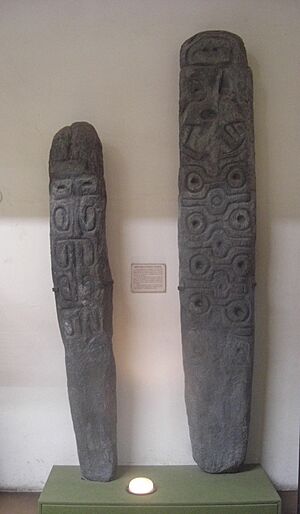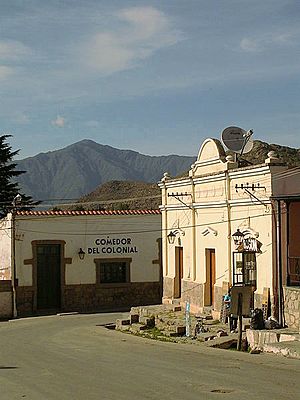Tafí del Valle facts for kids
Quick facts for kids
Tafí del Valle
Taktikllakta
|
|
|---|---|

Tafí del Valle
|
|
| Country | |
| Province | |
| Department | Tafí del Valle |
| Area | |
| • Total | 150 km2 (60 sq mi) |
| Elevation | 2,014 m (6,608 ft) |
| Population
(2010 census)
|
|
| • Total | 14,933 |
| • Density | 100/km2 (258/sq mi) |
| Demonym(s) | tafinisto/tafinista |
| Area code(s) | 03867 |
| Website | https://tafidelvalle.gob.ar/ |
Tafí del Valle is a city in Tucumán, Argentina. It is the main town in the department of the same name. You can find it in the western part of the Tucumán province. The city is about 126 kilometers (78 miles) away from San Miguel de Tucumán, which is the capital city of the province.
Contents
What's in a Name?
The original name for this area was Taktikllakta. This word comes from the Cacán language. It means "Town of the magnificent entrance." When the Spanish arrived, they shortened the name to Tafí. It's good to know that there's another town called Tafí Viejo in Tucumán province, so don't get them mixed up!
Where is Tafí del Valle?
The town of Tafí del Valle sits almost in the middle of the Tafí valley. This valley is special because it separates two large mountain ranges. To the south are the Sierra del Aconquija, and to the north are the Cumbres Calchaquíes. The valley acts like an important pathway. It connects the Calchaquí Valleys in the west with the big flat lands of the Chaco-Pampean plains in the east.
You can reach Tafí del Valle from San Miguel de Tucumán by taking National Route 38 and Provincial Route 307.
Earthquakes in the Region
Earthquakes happen often in the Tucumán province area. Most of them are not very strong. However, bigger earthquakes can occur about every 30 years. To keep people safe, the local government has plans. They do an earthquake drill every year. They also teach people what to do in case of a disaster. Signs are placed around the area to remind everyone that it's a place where earthquakes can happen.
Climate and Nature
Because Tafí del Valle is high up in the mountains, it has a mild climate. It doesn't get too humid, and it often snows in winter. The eastern part of the valley, where the town is, is moist. Here you'll see grasslands with groups of pine trees, trees that lose their leaves, and pepper trees.
As you go further west, it gets drier. This is where you might see cacti like the cardón. There's a clear difference at a place called Abra del Infiernillo. To the west, it looks like a desert, but to the east, you'll find green grasslands and forests. These areas are often covered in clouds.
In summer (January), the average highest temperature is about 26°C (79°F). In winter (July), it's around 16°C (61°F). It can get very cold in winter, sometimes as low as -20°C (-4°F).
| Climate data for Tafí del Valle (1936–1972) | |||||||||||||
|---|---|---|---|---|---|---|---|---|---|---|---|---|---|
| Month | Jan | Feb | Mar | Apr | May | Jun | Jul | Aug | Sep | Oct | Nov | Dec | Year |
| Mean daily maximum °C (°F) | 23.5 (74.3) |
23.1 (73.6) |
21.2 (70.2) |
19.4 (66.9) |
17.1 (62.8) |
16.1 (61.0) |
14.9 (58.8) |
17.1 (62.8) |
18.0 (64.4) |
20.0 (68.0) |
22.0 (71.6) |
23.1 (73.6) |
19.6 (67.3) |
| Daily mean °C (°F) | 18.2 (64.8) |
17.0 (62.6) |
15.6 (60.1) |
12.8 (55.0) |
10.8 (51.4) |
8.9 (48.0) |
8.1 (46.6) |
10.0 (50.0) |
11.3 (52.3) |
15.0 (59.0) |
16.0 (60.8) |
17.5 (63.5) |
13.4 (56.1) |
| Mean daily minimum °C (°F) | 13.3 (55.9) |
12.8 (55.0) |
11.2 (52.2) |
7.5 (45.5) |
4.2 (39.6) |
1.9 (35.4) |
1.1 (34.0) |
2.4 (36.3) |
5.1 (41.2) |
7.8 (46.0) |
10.8 (51.4) |
12.4 (54.3) |
7.5 (45.5) |
| Average precipitation mm (inches) | 98.9 (3.89) |
78.1 (3.07) |
51.5 (2.03) |
14.2 (0.56) |
4.5 (0.18) |
2.3 (0.09) |
4.7 (0.19) |
4.9 (0.19) |
7.9 (0.31) |
25.1 (0.99) |
52.8 (2.08) |
72.6 (2.86) |
417.5 (16.44) |
| Average relative humidity (%) | 70 | 72 | 70 | 65 | 59 | 57 | 53 | 49 | 48 | 54 | 59 | 66 | 60 |
| Source: Secretaria de Mineria | |||||||||||||
A Look at History
People have lived in the Tafí del Valle area for more than 7,000 years! Farmers and people who gathered food started building villages here about 2,300 years ago. This was even before the famous Tafí culture.
The Spanish first arrived in the mid-1500s. But they couldn't settle right away. Native groups like the Diaguitas and especially the Calchaquí tribe fought back strongly.
In 1636, a Spanish family named Leguizamo y Guevara was given the valley as a royal gift. They started a large farm called an estancia. Later, the Jesuits, a group of priests, bought this farm. The Jesuits had been in the area since 1617. They were important because they started dairy farming and made high-quality cheese.
What Tafí del Valle Makes
The climate in Tafí del Valle is great for raising animals. Long ago, people raised camelids (like llamas). After the Spanish came, they also raised cattle, sheep, and horses. Some goats are raised too.
Farmers also grow grains like wheat and vegetables like lettuce. The area is famous for its excellent quality cheeses. In the last half of the 1900s, tourism also became a very important part of the local economy.
Fun Things to Do
Since 2003, Tafí del Valle has become a popular spot for international tours in northwest Argentina.
The road from San Miguel de Tucumán to Tafí (RP307) is very scenic. It goes through the Tucumán forest and the Quebrada de los Sosa nature reserve. Along this road, you'll see interesting spots like the "El Indio" monument.
At the eastern entrance to the Tafí valley is a village called El Mollar. Both El Mollar and Tafí del Valle have many places for tourists to stay and enjoy.
One of the biggest attractions is the collection of menhirs at the Parque de los Menhires, near El Mollar. These are large, upright stones. Some of them have carvings made by the ancient people of the Tafí culture. They used to be scattered around the valley. But they were moved to this park to protect them from damage.
Close to El Mollar, you'll find the artificial lake of Angostura. It's surrounded by mountains, sometimes covered in snow. You can go fishing and do water sports here. A fast, clear river called Los Sosa flows from this lake. It travels east through canyons and over waterfalls.
Less than a kilometer from Tafí is the Jesuit center of La Banda. This building was made in the early 1700s and is now a museum. There's also the Ñuñorco Grande hill nearby. About 2 kilometers from town, on Provincial Route 307, is the Casa Duende museum. It teaches about local beliefs, myths, and traditions.
If you keep going north, you'll get amazing views of the valley. This route leads to other towns like Amaicha del Valle, the ruins of Quilmes, El Pichao, Colalao del Valle, and Cafayate. Cafayate is in Salta and is known for its great wines.
In Tafí, you can go horse riding, take tours in 4x4 vehicles, go trekking, try windsurfing or paragliding. You can also visit old churches and farms.
Yearly Events
- During Holy Week, local actors put on a play about the Passion of Christ. More and more people come to watch this every year.
- In summer, there's a tournament for pato. This is Argentina's national sport, played on horseback. Athletes from all over the country come to compete.
- The National Cheese Festival happens every February. It celebrates the delicious cheeses made in Tafí.
People of Tafí del Valle
In 2001, about 5,000 people lived in the town of Tafí del Valle itself. However, because it's the capital of its department, the total population number includes people from other small towns within about 15 kilometers (9 miles).
Delicious Food
The cheeses from Tafí have been made since the 1700s and are known for being excellent. Another local favorite is cottage cheese (called quesillo). You can enjoy it in many ways, like a dessert with honey or a sweet preserve made from cayote fruit. These might be served with kiwifruit or grapes.
Other tasty dishes include roasted beef or kid. A special treat is grilled trout from the nearby lake, seasoned with lemon. To drink, you might try white Torrontés wine from the Calchaquí valleys or beer brewed in San Miguel de Tucumán.
See also
 In Spanish: Tafí del Valle para niños
In Spanish: Tafí del Valle para niños




